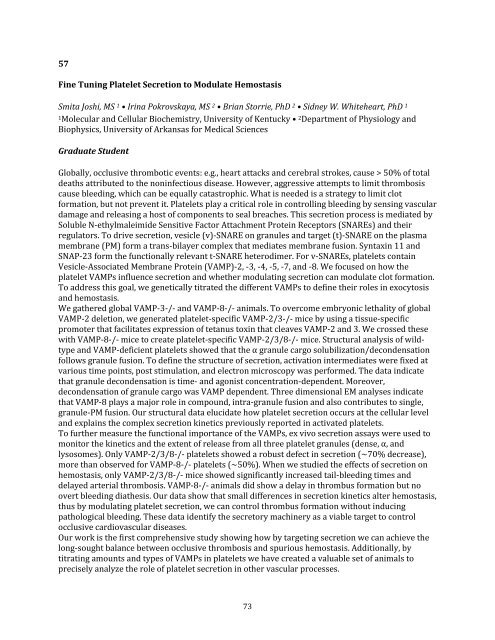2017 Cardiovascular Research Day Abstract Book
Create successful ePaper yourself
Turn your PDF publications into a flip-book with our unique Google optimized e-Paper software.
57<br />
Fine Tuning Platelet Secretion to Modulate Hemostasis<br />
Smita Joshi, MS 1 • Irina Pokrovskaya, MS 2 • Brian Storrie, PhD 2 • Sidney W. Whiteheart, PhD 1<br />
1Molecular and Cellular Biochemistry, University of Kentucky • 2 Department of Physiology and<br />
Biophysics, University of Arkansas for Medical Sciences<br />
Graduate Student<br />
Globally, occlusive thrombotic events: e.g., heart attacks and cerebral strokes, cause > 50% of total<br />
deaths attributed to the noninfectious disease. However, aggressive attempts to limit thrombosis<br />
cause bleeding, which can be equally catastrophic. What is needed is a strategy to limit clot<br />
formation, but not prevent it. Platelets play a critical role in controlling bleeding by sensing vascular<br />
damage and releasing a host of components to seal breaches. This secretion process is mediated by<br />
Soluble N-ethylmaleimide Sensitive Factor Attachment Protein Receptors (SNAREs) and their<br />
regulators. To drive secretion, vesicle (v)-SNARE on granules and target (t)-SNARE on the plasma<br />
membrane (PM) form a trans-bilayer complex that mediates membrane fusion. Syntaxin 11 and<br />
SNAP-23 form the functionally relevant t-SNARE heterodimer. For v-SNAREs, platelets contain<br />
Vesicle-Associated Membrane Protein (VAMP)-2, -3, -4, -5, -7, and -8. We focused on how the<br />
platelet VAMPs influence secretion and whether modulating secretion can modulate clot formation.<br />
To address this goal, we genetically titrated the different VAMPs to define their roles in exocytosis<br />
and hemostasis.<br />
We gathered global VAMP-3-/- and VAMP-8-/- animals. To overcome embryonic lethality of global<br />
VAMP-2 deletion, we generated platelet-specific VAMP-2/3-/- mice by using a tissue-specific<br />
promoter that facilitates expression of tetanus toxin that cleaves VAMP-2 and 3. We crossed these<br />
with VAMP-8-/- mice to create platelet-specific VAMP-2/3/8-/- mice. Structural analysis of wildtype<br />
and VAMP-deficient platelets showed that the α granule cargo solubilization/decondensation<br />
follows granule fusion. To define the structure of secretion, activation intermediates were fixed at<br />
various time points, post stimulation, and electron microscopy was performed. The data indicate<br />
that granule decondensation is time- and agonist concentration-dependent. Moreover,<br />
decondensation of granule cargo was VAMP dependent. Three dimensional EM analyses indicate<br />
that VAMP-8 plays a major role in compound, intra-granule fusion and also contributes to single,<br />
granule-PM fusion. Our structural data elucidate how platelet secretion occurs at the cellular level<br />
and explains the complex secretion kinetics previously reported in activated platelets.<br />
To further measure the functional importance of the VAMPs, ex vivo secretion assays were used to<br />
monitor the kinetics and the extent of release from all three platelet granules (dense, α, and<br />
lysosomes). Only VAMP-2/3/8-/- platelets showed a robust defect in secretion (~70% decrease),<br />
more than observed for VAMP-8-/- platelets (~50%). When we studied the effects of secretion on<br />
hemostasis, only VAMP-2/3/8-/- mice showed significantly increased tail-bleeding times and<br />
delayed arterial thrombosis. VAMP-8-/- animals did show a delay in thrombus formation but no<br />
overt bleeding diathesis. Our data show that small differences in secretion kinetics alter hemostasis,<br />
thus by modulating platelet secretion, we can control thrombus formation without inducing<br />
pathological bleeding. These data identify the secretory machinery as a viable target to control<br />
occlusive cardiovascular diseases.<br />
Our work is the first comprehensive study showing how by targeting secretion we can achieve the<br />
long-sought balance between occlusive thrombosis and spurious hemostasis. Additionally, by<br />
titrating amounts and types of VAMPs in platelets we have created a valuable set of animals to<br />
precisely analyze the role of platelet secretion in other vascular processes.<br />
73


